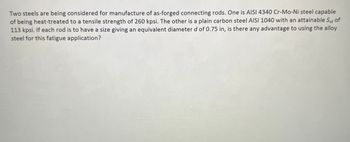
Elements Of Electromagnetics
7th Edition
ISBN: 9780190698614
Author: Sadiku, Matthew N. O.
Publisher: Oxford University Press
expand_more
expand_more
format_list_bulleted
Concept explainers
Question

Transcribed Image Text:Two steels are being considered for manufacture of as-forged connecting rods. One is AISI 4340 Cr-Mo-Ni steel capable
of being heat-treated to a tensile strength of 260 kpsi. The other is a plain carbon steel AISI 1040 with an attainable Sut of
113 kpsi. If each rod is to have a size giving an equivalent diameter d of 0.75 in, is there any advantage to using the alloy
steel for this fatigue application?
Expert Solution
This question has been solved!
Explore an expertly crafted, step-by-step solution for a thorough understanding of key concepts.
Step by stepSolved in 5 steps with 18 images

Knowledge Booster
Learn more about
Need a deep-dive on the concept behind this application? Look no further. Learn more about this topic, mechanical-engineering and related others by exploring similar questions and additional content below.Similar questions
- A rectangular bar is cut from an AISI 1020 cold-drawn steel flat. The bar is 2.500 in wide by 4/8 in thick and has a 0.500-in-dia. hole drilled through the center as depicted in Table A-15-1. The bar is concentrically loaded in push-pull fatigue by axial forces Fa, uniformly distributed across the width. Using a design factor of na = 2, estimate the largest force Fa that can be applied ignoring column action. What is the largest force that can be applied to the part? (Round the final answer to three decimal places.) The largest force that can be applied is kips.arrow_forwardA rectangular bar is cut from an AISI 1020 cold-drawn steel flat. The bar is 2.500 in wide by 4/8 in thick and has a 0.500-in-dia. hole drilled through the center as depicted in Table A-15–1. The bar is concentrically loaded in push-pull fatigue by axial forces Fa, uniformly distributed across the width. Using a design factor of na = 2, estimate the largest force Fa that can be applied ignoring column action. What are the values of the theoretical stress-concentration factor, the notch sensitivity, and the fatigue stress-concentration factor? The value of the theoretical stress-concentration factor is The value of the notch sensitivity is (Round the final answer to three decimal places.) The value of the fatigue stress-concentration factor is (Round the final answer to three decimal places.)arrow_forwardA bar AISI 1035 steel forged and heat treated with minimum yield strength of 570MPa is subjected to bending moment of 290Nm and a torsional moment of 310Nm. Assuming a factor of safety of 2, determine the diameter of rod using the following theories of failure (i) Maximum Shear stress theory and (ii) Distortion Energy theory (iii) Maximum stress theory, also specify which diameter is considered as safearrow_forward
- A right angle bracket arm experiences a downward normal force F(t) which cycles continuously between a minimum of 100 Lbs to a maximum of 400 Lbs. The machined part is made from 4140 steel, quenched & tempered at 800°F (Table A-21). Determine the factor of safety of the 5/8- inch diameter shaft at point A based on a life >10 million cycles using the DE - ASME-Elliptic Fatigue Failure Theory. Consider 90 % reliability and room temperatures. Assume stress concentrations, Kf = Kt = 1.7 and Kfs = Kts = 1.4 at point A. List governing equations and show all work.arrow_forwardThe round cross-sectional bar is cut from an AISI 1020 colddrawn steel with a diameter of 25 mm. The bar is loaded at its end with a completely reversed load Fmin = 5 kN, Fmax = -3 kN. Using a design factor of nd = 1.2, what will be the maximum length of the bar that prevents failure using Modified Goodman criteria? What length must be used if a more conservative criteria is used?arrow_forwardI need help solving this problemarrow_forward
arrow_back_ios
arrow_forward_ios
Recommended textbooks for you
 Elements Of ElectromagneticsMechanical EngineeringISBN:9780190698614Author:Sadiku, Matthew N. O.Publisher:Oxford University Press
Elements Of ElectromagneticsMechanical EngineeringISBN:9780190698614Author:Sadiku, Matthew N. O.Publisher:Oxford University Press Mechanics of Materials (10th Edition)Mechanical EngineeringISBN:9780134319650Author:Russell C. HibbelerPublisher:PEARSON
Mechanics of Materials (10th Edition)Mechanical EngineeringISBN:9780134319650Author:Russell C. HibbelerPublisher:PEARSON Thermodynamics: An Engineering ApproachMechanical EngineeringISBN:9781259822674Author:Yunus A. Cengel Dr., Michael A. BolesPublisher:McGraw-Hill Education
Thermodynamics: An Engineering ApproachMechanical EngineeringISBN:9781259822674Author:Yunus A. Cengel Dr., Michael A. BolesPublisher:McGraw-Hill Education Control Systems EngineeringMechanical EngineeringISBN:9781118170519Author:Norman S. NisePublisher:WILEY
Control Systems EngineeringMechanical EngineeringISBN:9781118170519Author:Norman S. NisePublisher:WILEY Mechanics of Materials (MindTap Course List)Mechanical EngineeringISBN:9781337093347Author:Barry J. Goodno, James M. GerePublisher:Cengage Learning
Mechanics of Materials (MindTap Course List)Mechanical EngineeringISBN:9781337093347Author:Barry J. Goodno, James M. GerePublisher:Cengage Learning Engineering Mechanics: StaticsMechanical EngineeringISBN:9781118807330Author:James L. Meriam, L. G. Kraige, J. N. BoltonPublisher:WILEY
Engineering Mechanics: StaticsMechanical EngineeringISBN:9781118807330Author:James L. Meriam, L. G. Kraige, J. N. BoltonPublisher:WILEY

Elements Of Electromagnetics
Mechanical Engineering
ISBN:9780190698614
Author:Sadiku, Matthew N. O.
Publisher:Oxford University Press

Mechanics of Materials (10th Edition)
Mechanical Engineering
ISBN:9780134319650
Author:Russell C. Hibbeler
Publisher:PEARSON

Thermodynamics: An Engineering Approach
Mechanical Engineering
ISBN:9781259822674
Author:Yunus A. Cengel Dr., Michael A. Boles
Publisher:McGraw-Hill Education

Control Systems Engineering
Mechanical Engineering
ISBN:9781118170519
Author:Norman S. Nise
Publisher:WILEY

Mechanics of Materials (MindTap Course List)
Mechanical Engineering
ISBN:9781337093347
Author:Barry J. Goodno, James M. Gere
Publisher:Cengage Learning

Engineering Mechanics: Statics
Mechanical Engineering
ISBN:9781118807330
Author:James L. Meriam, L. G. Kraige, J. N. Bolton
Publisher:WILEY